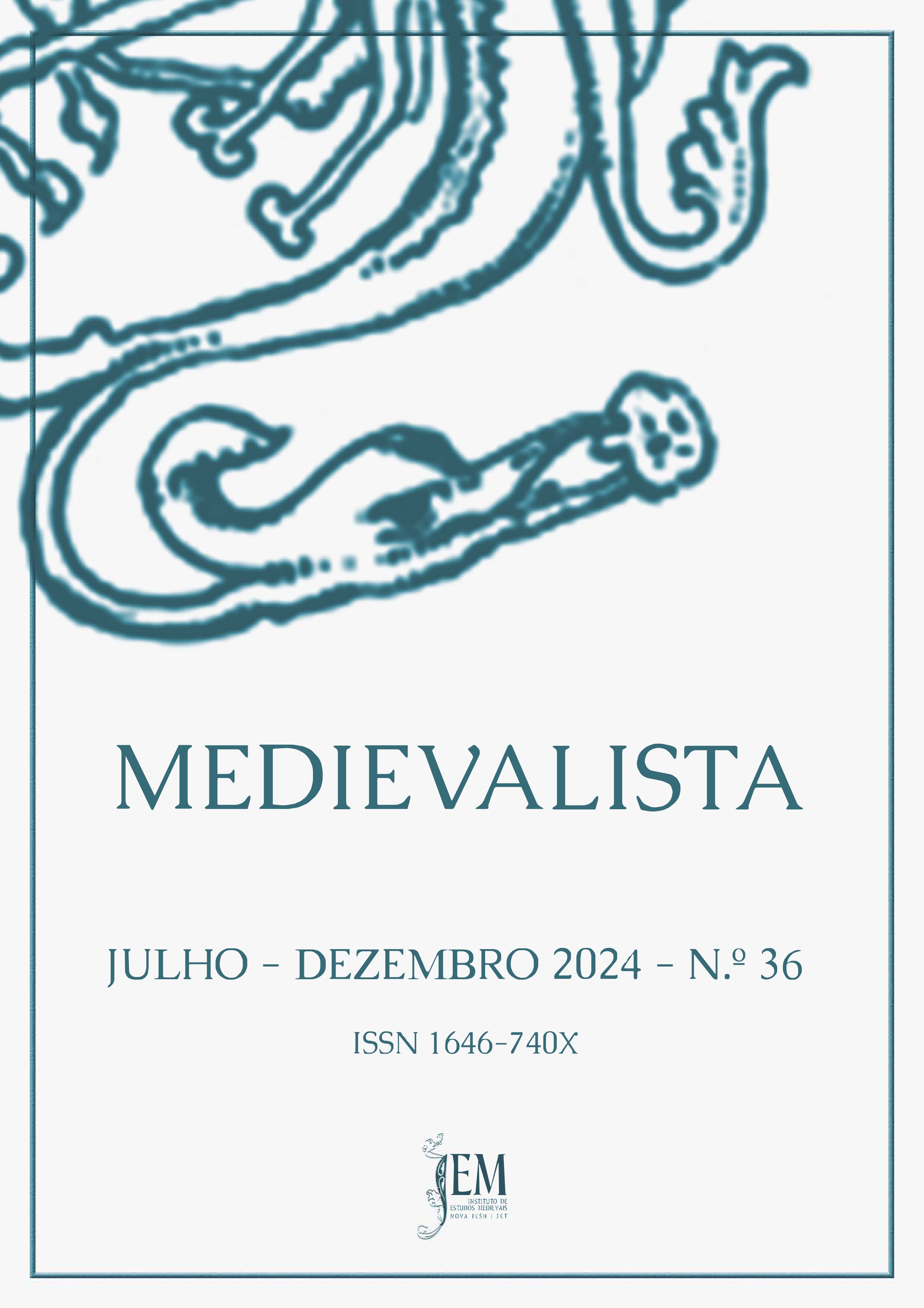The Doukai and the hardly apportioned reward: the (failed) quest for shared power under Alexios I (1081-1118)
DOI:
https://doi.org/10.4000/medievalista.8392Keywords:
Power-sharing, Byzantine Empire, Alexios I, Komnenos, DoukasAbstract
The rebellion that brought the Komnenoi to power in 1081 was successful because it had many supporters, the most important of which was the Doukai, a lineage that had already controlled imperial power and with which Alexios was linked by marriage. The traditional position of historiography is that this was the beginning of an aristocratic government in which the emperor’s relatives enjoyed a share of power. However, more recent studies dispute the extent of the distribution of power under the Komnenoi (1081-1118), claiming that these emperors were more centralizing and traditional than previously thought. However, in fact, the emperors did distribute power, especially Alexios I (1081-1118), but in a more restricted and ad hoc way. Thus, given the Doukas’ role in the rebellion, it was expected that Alexios I would share power with this family, but he preferred to do so with his mother and brother. The Doukas, feeling aggrieved, spared no effort to gain a foothold in the regime, resulting in a series of internal crises that pitted various members of the family consortium that had seized power against each other. In the end, they were unsuccessful. However, this claim for shared power produced a parallel identity for the Doukas and corresponding discourses, which lasted after the death of Alexios I and continued to exist during the reign of John II (1118-1143). This identity emphasized the role of this family in seizure of power and the legitimization of the new emperor, as well as demanded space and power. This article will deal with these issues.
Bibliographic references
Sources
ANA COMNENA ‒ Alexíada. Ed. Diether R. Reinsch e Athanasios Kambylis, Annae Comnenae Alexias: Pars Prior Prolegomena et Textus. Corpus Fontium Historiae Byzantinae 40. Berlim, Nova York: de Gruyter, 2001. Diether R. Reinsch, Alexias Anna Komnene. Colônia: Dumont, 1996.
Decretum editum circa unionem synodi cum Leone Chalcedonensi, et circa piam sententiam de adoratione sanctorum imaginum, ab optimo et sancto imperatore nostro domino Alexio Comneno, qui per Dei gratiam pietate conspicuus fuit, ed. Jacques Paul Migne. Patrologia Graeca 127. Paris: Migne, 1864, 971-984.
JOÃO ZONARAS ‒ Epítome de Histórias, ed. Theodor Büttner-Wobst, Ioannis Zonarae epitomae historiarum libri xviii. Vol. 3. Corpus Scriptorum Historiae Byzantinae 45. 3. Bonn: Weber, 1897. Trad. Erich Trapp, Militärs und Höflinge im Ringe um das Kaisertum. Byzantinische Geschichte von 969 bis 1118 nach der Chronik des Johannes Zonaras (Byzantinische Geschichtsschreiber 16), Graz, Viena, Colônia: Styria, 1986.
JORGE TORNIQUES ‒ Elogio a Ana Comnena. Ed. e Trad. DARROUZÈS, Jean. Georges et Dèmètrios Tornikès. Lettres et Discours. Paris: Éditions du centre national de la recherche scientifique, 1970, pp. 220-323.
Miguel Ataliates - História, ed. Eudoxos Th. Tsolakis, Michaelis Attaliatae Historia. Corpus Fontium Historiae Byzantinae 50. Atenas: Κέντρον Ἐυρἐυνης τῆς Ἑλληνικῆς καὶ Λατινικῆς Γραμματείας, 2011. Tr. Anthony Kaldellis e Dimitris Krallis, The History. Michael Attaleiates. Dumbarton Oaks Medieval Library 16. Cambridge, EUA; Londres: Harvard University Press, 2012.
Miguel, o Sírio ‒ Crônica, Ed. e trans. J.-B. Chabot, Chronique de Michel le Syrien, patriarche Jacobite d'Antioche (1166 – 1199). Vol. 3. Bruxelas: Ernest Leroux, 1905.
Miguel Pselo ‒ Cronografia. Ed. Diether R. Reinsch, Michaelis Pselli Chronographia. Millenium Studies, 51, Berlim, Boston: De Gruyter, 2014.
NICÉFORO BRIÊNIO - Material de História. Ed. e tr. Paul Gautier, Nicephori Bryenni Historiarum Libri Quattuor. Bruxelas: Byzantion, 1975.
Nicetas Coniates ‒ Narrativa cronológica. Ed. Jan-Louis Van Dieten, Nicetae Choniatae Historia. Vol. 1. Corpus Fontium Historiae Byzantinae 11. Berlim: De Gruyter, 1975. Trad. Franz Grabler, Die Krone der Komnenen. Die Regierungszeit der Kaiser Joannes und Manuel Komnenos (1118 – 1180) aus dem Geschichtswerk des Niketas Choniates. Byzantinische Geschichtsschreiber 7. Graz, Viena, Colônia: Styria, 1958.
SKYLITZES CONTINUATUS, ed. ed. Eudoxos Th. Tsolakis, Ἡ συνέχεια τῆς χρονογραφίας τοῦ Ἰωάννου Σκυλίτση, Tessalônica: Εταιρεία Μακεδονικών Σπουδών, 1968. Tr. Eric McGeer, Byzantium in the Time of Troubles: The Continuation of the Chronicle of John Skylitzes (1057−1079). The Medieval Mediterranean. Peoples, Economies and Cultures, 400-1500 120. Leiden, Boston: Brill, 2020.
TEOFILACTO DE OCRIDA, Discurso ao autokrator senhor Aleixo Comneno. ed. e trad. Paul Gautier, Theophylacti Achridensis Orationes, Tractatus, Carmina. Tessalônica: Association de recherches byzantines, 1980, p. 213-243.
TEOFILACTO DE OCRIDA ‒ Cartas. Ed. e trad. Paul Gautier, Theophylacti Achridensis Epistulae. Corpus Fontium Historiae Byzantinae 16, 2. Tessalônica: Association de recherches byzantines, 1986. no. 84, pp. 440-443.
Typikon de Kecharitomene. Ed. e trad. Paul Gautier, “Le typikon de la Théotokos Kécharitôménè”, Revue des études byzantines 43 (1985), pp. 5–165. Trad. Robert Jordan, “Typikon of Empress Irene Doukaina Komnene for the Convent of the Mother of God Kecharitomene in Constantinople”. In Thomas, John; Hero, Angela Constantinides (eds.) ‒ Byzantine Monastic Foundation Documents. A Complete Translation of the Surviving Founders’ Typika and Testaments, Washington: Dumbarton Oaks, 2000, pp. 649–724.
Studies
Beck, Hans-Georg ‒ “Der byzantinische “Ministerpräsident””. Byzantinische Zeitschrift 48 (1955) [reimpr. in: Ideen und Realitaeten in Byzanz. Gesammelte Aufsatze, London 1972, Art. no. 13], pp. 309–338.
CHEYNET, Jean-Claude ‒ “Les Dalassènoi”. In Cheynet, Jean-Claude; Vannier, Jean-François (eds.) ‒ Études Prosopographiques. Byzantina Sorbonnensia 5. Paris: Publications de la Sorbonne, 1986, pp. 75-115, [reimpr. in: Cheynet, Jean-Claude (ed.) ‒ La société byzantine. L'apport des sceaux. Vol. 2. Paris: Association des amis du Centre d'histoire et civilisation de Byzance, 2008, pp. 413–471].
DIAS, João Vicente de Medeiros Publio ‒ The Political Opposition to Alexios I Komnenos (1081-1118). Mainz: Universidade Johannes Gutenberg de Mainz, 2020. Tese de doutorado.
DIAS, João Vicente de Medeiros Publio ‒ “Isaac and Alexios I Komnenos (1081-1118): A Reassessment of a Unique Power-Sharing Arrangement between Brothers”. In BOSSELMANN-RUICKBIE, Antje; CHITWOOD, Zachary; PAHLITZSCH, Johannes; VUČETIĆ, Martin Marko (eds.) ‒ Byzanz am Rhein: Festschrift für Günter Prinzing anlässlich seines 80. Geburtstags. Wiesbaden: Harrassowitz, 2024, p. 43‒64.
DENNIS, George T. ‒ “Imperial Panegyric: Rhetoric and Reality”. In Maguire, Henry (ed.) ‒ Byzantine Court Culture from 829 to 1204. Washington D.C: Dumbarton Oaks, 1997, pp. 131-140.
Dimitropoulou, Vassiliki ‒ “Imperial women founders and refounders in Komnenian Constantinople”. In MULLETT, Margaret (ed.) ‒ Founders and refounders of Byzantine monasteries. Belfast Byzantine Texts and Translations, 6.3. Belfast: Pryory, 2007, pp. 87-106.
DÖLGER, Franz ‒ Regesten der Kaiserurkunden des oströmischen Reiches von 565–1453, 2: Regesten von 1025–1204. Zweite, erweiterte und verbesserte Auflage bearbeitet von Peter Wirth mit Nachträgen zu Regesten Faszikel 3, Munique: C. H. Beck, 1995
FRANKOPAN, Peter ‒ “Challenges to Imperial Authority in the Reign of Alexios I Komnenos. The Conspiracy of Nikephoros Diogenes”. Byzantinoslavica 64 (2006), pp. 257–274.
FRANKOPAN, Peter ‒ “The Fall of Nicaea and the Towns of Western Asia Minor to the Turks in the Later 11th Century: The Curious Case of Nikephoros Melissenos”. Byzantion 76 (2006), pp. 153-184.
FRANKOPAN, Peter ‒ “Kinship and the Distribution of Power in Komnenian Byzantium”. English Historical Review 123 (2007), pp. 1–34.
FRANKOPAN, Peter ‒ “Re-interpreting the Role of the Family in Comnenian Byzantium: Where Blood is not Thicker than Water”. In LAUXTERMANN, Marc D.; WHITTOW, Mark (eds.) ‒ Byzantium in the Eleventh Century: Being in Between. Papers from the 45th Spring Symposium of Byzantine Studies, Exeter College, Oxford, 24‒6 March 2012. Londres; Nova York: Routledge, 2017, pp. 181-196.
Garland, Lynda ‒ Byzantine Empresses. Women and Power in Byzantium, 527-1204, Londres: Routledge, 1999.
Gautier Paul ‒ “L'obituaire du typikon du Pantokrator”. Revue des études byzantines 27 (1969), pp. 235-262.
Gautier, Paul ‒ “Le synode des Blachernes (fin 1094). Étude prosopographique”. Revue des études byzantines 29 (1971), pp. 213 - 284.
Gerhold, Victoria Casamiquela ‒ “Le “mouvement chalcédonien”. Opposition ecclésiastique et aristocratique sous le règne d’Alexis Comnène (1081–1094)”. Erytheia 33 (2012), pp. 87-104.
Grumel, Venance ‒ “Les documents athonites concernant l'affaire de Léon de Chalcédoine”. Studi e Testi 123 (1946), pp. 116–135.
GUILLAND, Rodolph ‒Recherches sur les institutions byzantines. Vol. 2. Berlin: Akademie-Verlag, 1967.
Hill, Barbara ‒ Imperial Women in Byzantium, 1025–1204. Power, Patronage and Ideology. Londres; Nova York: Routledge, 1989.
KALDELLIS, Anthony ‒ Streams of Gold, Rivers of Blood. The Rise and Fall of Byzantium, 955 A.D. to the First Crusade. Nova York: Oxford University Press, 2017.
KAPLAN, Michel ‒ “Why were monasteries founded?”. In MULLETT, Margaret (ed.) ‒ Founders and refounders of Byzantine monasteries. Belfast Byzantine Texts and Translations, 6.3. Belfast: Pryory, 2007, pp. 28-42.
MAGDALINO, Paul ‒ The Empire of Manuel I Komnenos, 1143–1180. Cambridge: Cambridge University Press, 1993.
Magdalino, Paul ‒ “The Pen of the Aunt. Echoes of the Mid-twelfth Century in the Alexiad”. In Gouma-Peterson, Thalia (ed.) ‒ Anna Komnene and Her Times. Nova York, Londres: Garland, 2000, pp. 14–43.
MAGDALINO, Paul ‒ “Occult Science and Imperial Power in Byzantine History and Historiography (9th‒12th Centuries)”. In MAGDALINO, Paul; MAVROUDI, Maria ‒ The Occult Sciences in Byzantium. Genebra: Le Pomme d’or, 2006, pp. 119-162
Morris, Rosemary ‒ Monks and Layman in Byzantium, 886–1118. Cambridge: Cambridge University Press, 1995.
MORRIS, Rosemary ‒ “The Byzantine Aristocracy and the Monasteries”. In ANGOLD, Michael (ed.) – The Byzantine Aristocracy: IX to XII Centuries. Oxford: B.A.R, 1984, pp. 112-137.
MULLETT, Margaret ‒ “Founders, refounders, second founders, patrons”. In MULLETT, Margaret (ed.) ‒ Founders and refounders of Byzantine monasteries. Belfast Byzantine Texts and Translations, 6.3. Belfast: Pryory, 2007, pp. 1-27.
Neville, Leonora ‒ “A history of the caesar John Doukas in Nikephoros Bryennios’ Material for History?”. Byzantine and Modern Greek Studies 32 (2008), pp. 168-188.
Neville, Leonora ‒ Heroes and Romans in Twelfth-Century Byzantium. The Material for History of Nikephoros Bryennios. Cambridge: Cambridge University Press, 2012.
Neville, Leonora ‒ Anna Komnene. the Life and Work of a Medieval Historian. Oxford: Oxford University Press, 2016.
OUSTERHOUT, Robert ‒ “Architecture, Art and Komnenian Ideology at the Pantokrator Monastery”. In NECIPOĞLU, Nevra ‒ Byzantine Constantinople. Monuments, Topography and Everyday Life. The Medieval Mediterranean. Peoples, Economies and Cultures, 400-1500 33. Leiden; Boston; Colônia: Brill, 2001, pp. 133-150.
Polemis, Demetrios ‒ The Doukai. A Contribution to Byzantine Prosopography. University of London Historical Studies 22. Londres: Athlone, 1968.
RYDER, Judith ‒ “Leo of Chalcedon. Conflicting ecclesiastical models in the Byzantine eleventh century”. In LAUXTERMANN, Marc D.; WHITTOW, Mark (eds.) ‒ Byzantium in the Eleventh Century: Being in Between. Papers from the 45th Spring Symposium of Byzantine Studies, Exeter College, Oxford, 24‒6 March 2012. Society of the Promotion of Byzantine Studies Publications 19. Londres; Nova York: Routledge, 2017, pp. 169-180.
SIMPSON, Alicia Josephine ‒ “Book Review: Leonora NEVILLE, Anna Komnene: The Life and Work of a Medieval Historian. Oxford: Oxford University Press, 2016”. Byzantina Symmeikta 28 (2018), pp. 381–383.
STANKOVIC, Vlada ‒ Komnini u Carigradu (1057 – 1185). Evolucija jedne vladarske porodice. Belgrado: Vizantološki in-t SANU, 2006.
Stanković, Vlada ‒ “Comnenian Monastic Foundations in Constantinople: Questions of Method and Historical Context”. Belgrade Historical Review 2 (2011), pp. 47-73.
Stanković, Vlada; Berger, Albrecht ‒ “The Komnenoi and Constantinople before the Building of the Pantokrator Complex”. In Kotzabassi, Sofia (ed.) ‒ The Pantokrator Monastery in Constantinople. Byzantinisches Archiv 27. Boston; Berlim: De Gruyter, 2013, pp. 3–32.
Stathakopoulos, Dionysios ‒ “John II Komnenos: a Historiographical Essay”. In Bucossi, Alessandra; Suárez, Alex Rodriguez (eds) ‒ John II Komnenos, Emperor of Byzantium: In the Shadow of Father and Son. Farnham: Ashgate, 2016, pp. 1-10.
SYNCLAIR, Kyle James ‒ War Writing in Middle Byzantine Historiography. Sources, Influences and Trends. Birmingham: Universidade de Birmingham, 2012. Tese de doutoramento.
Thomas, John Philip ‒ Private Religious Foundations in the Byzantine Empire. Dumbarton Oaks Studies 24. Washington: Dumbarton Oaks, 1984.
VARZOS, Konstantinos ‒ Ἡ γενεαλογία τών Κομνηνών. Vol. 1. Tessalônica: Κέντρον Βυζαντινών Ερευνών, 1984.
VILIMONOVIĆ, Larisa Orlov ‒ Structure and Features of Anna Komnene’s Alexiad: Emergence of a Personal History. Amsterdam: Amsterdam University Press, 2019.
Witakowski, Witold ‒ “Syriac Historiographical Sources”. In WHITBY, Mary (ed.) ‒ Byzantines and Crusaders in Non-Greek Sources, 1025-1204. Oxford: Oxford University Press, 2007, pp. 253-282.
Downloads
Published
How to Cite
Issue
Section
License
Copyright (c) 2024 Medievalista

This work is licensed under a Creative Commons Attribution 4.0 International License.





